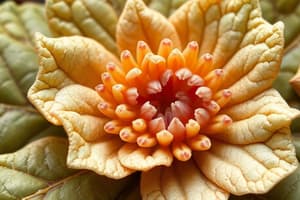Podcast
Questions and Answers
What is the primary function of stomata in plants?
What is the primary function of stomata in plants?
- Help in the removal of excess oxygen from the plant
- Regulate water intake for photosynthesis
- Regulate temperature inside the plant
- Facilitate the uptake of carbon dioxide for photosynthesis (correct)
What surrounds each stoma and regulates its opening and closing?
What surrounds each stoma and regulates its opening and closing?
- Guard cells (correct)
- Chloroplasts
- Xylem vessels
- Root hairs
Why do stomata close at night?
Why do stomata close at night?
- To increase carbon dioxide intake for respiration
- To trap oxygen inside the plant
- To minimize water loss through transpiration (correct)
- To prevent insects from entering the plant
Which gas enters the plant through stomata during photosynthesis?
Which gas enters the plant through stomata during photosynthesis?
Besides gas exchange, what is another important function of stomata?
Besides gas exchange, what is another important function of stomata?
In which part of a plant are stomata commonly found?
In which part of a plant are stomata commonly found?
What happens to stomata when there is low light intensity and high humidity?
What happens to stomata when there is low light intensity and high humidity?
Which layer of the leaf contains the stomata?
Which layer of the leaf contains the stomata?
What is the role of guard cells in relation to stomata?
What is the role of guard cells in relation to stomata?
Which type of vein transports water and nutrients throughout the leaf?
Which type of vein transports water and nutrients throughout the leaf?
What is the function of spongy tissue in a leaf?
What is the function of spongy tissue in a leaf?
How does an increase in light intensity affect stomata?
How does an increase in light intensity affect stomata?
Flashcards are hidden until you start studying
Study Notes
Gas Exchange in Plants - Understanding Stomata and Leaf Structure
Plants need to absorb carbon dioxide from their environment to produce energy through photosynthesis. This gas exchange process occurs primarily at specialized structures called stomata found on plant leaves. To understand how this works, let's delve into the intricacies of stomata and leaf structure.
What Are Stomata?
Stomata (singular: stoma) are microscopic openings on the surface of plant leaves, stems, and occasionally other parts of the plant like petioles. Each stoma is surrounded by two guard cells, which regulate its opening and closing based on environmental conditions. These tiny pores allow gases like carbon dioxide (CO2) to enter and oxygen (O2) to exit the plant during photosynthesis. They also serve another important function—they help control water loss, known as transpiration, from the plant.
Why Are Stomata Important?
The primary role of stomata is to facilitate the uptake of CO2, which is essential for photosynthesis. During daylight hours, stomata usually remain open, allowing CO2 in and O2 out. At night, they close to minimize water loss. This cyclical behavior ensures that the plant can perform photosynthesis effectively while conserving water. However, it also means that when stomata are closed, the plant cannot take up CO2, so there is no production of food via photosynthesis either.
How Do Stomata Work?
When there is high light intensity and low humidity, stomata tend to be more open. Conversely, under low light levels and high humidity, stomata may be less open, reducing water loss through transpiration. Water vapor diffuses out of the plant through these openings, and the pressure change causes the guard cells around them to expand and pull apart, increasing the size of the stomatal pore. When environmental conditions become unfavorable, the guard cells shrink back together, thus closing the stomata.
Leaf Structure and Its Relationship with Gas Exchange
Leaves aren't just flat sheets; they have a complex structure that plays a vital role in gas exchange and overall plant health. One key feature is the presence of veins, which transport water and nutrients throughout the leaf. There are three main types of veins in a leaf: midrib veins, secondary veins (or lateral veins), and tertiary veins (or minor veins). These veins create a network that allows for efficient distribution of water and nutrients to the various regions of the leaf where gas exchange takes place.
Also crucial to gas exchange are the leaf's epidermis and mesophyll layers. The epidermis is the outermost layer of the leaf and contains the stomata. Beneath the epidermis lies the mesophyll, which consists of palisade and spongy tissue layers. The palisade tissue is responsible for the initial stages of photosynthesis, while the spongy tissue provides additional support and room for gas exchange. Together, these structural elements create an optimal environment for efficient gas exchange within the leaf.
In summary, understanding stomata and leaf structure is key to unraveling how plants conduct gas exchange. Stomata play a critical role in enabling plants to take in CO2 and release O2, while the leaf's structure supports efficient gas exchange processes. By studying these components, biologists and agronomists can better understand plant growth, productivity, and response to changing environmental conditions.
Studying That Suits You
Use AI to generate personalized quizzes and flashcards to suit your learning preferences.




